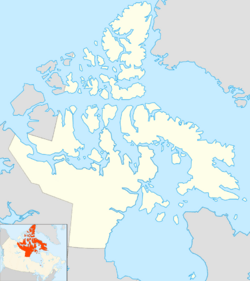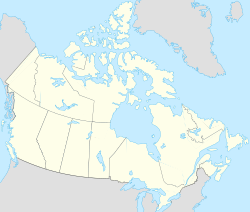Edmund Walker Island facts for kids
| Geography | |
|---|---|
| Location | Arctic Ocean |
| Coordinates | 77°07′N 104°10′W / 77.117°N 104.167°W |
| Archipelago | Findlay Group Queen Elizabeth Islands Canadian Arctic Archipelago |
| Area | 82 km2 (32 sq mi) |
| Administration | |
|
Canada
|
|
| Nunavut | Nunavut |
| Region | Qikiqtaaluk |
| Demographics | |
| Population | Uninhabited |
Edmund Walker Island is a small, uninhabited island located far north in Canada's Arctic. It's part of a huge group of islands known as the Canadian Arctic Archipelago, which are found in the cold Arctic Ocean. This island is a remote and icy place, mostly covered in snow and ice for much of the year.
Contents
Exploring Edmund Walker Island
Edmund Walker Island is one of the many islands that make up the vast Canadian Arctic Archipelago. This huge collection of islands is located in the northern part of Canada, stretching into the Arctic Ocean. The island is part of Nunavut, which is Canada's largest and northernmost territory.
Where is Edmund Walker Island?
This island is found in the Arctic Ocean. It lies to the south-east of a larger island called Lougheed Island. To its north-west is another island known as Grosvenor Island. Edmund Walker Island is also a member of a smaller group of islands called the Findlay Group.
The coordinates for Edmund Walker Island are 77°07′N latitude and 104°10′W longitude. These numbers help pinpoint its exact location on a map, showing just how far north it is.
How Big is the Island?
Edmund Walker Island covers an area of about 82 square kilometers (about 32 square miles). To give you an idea, that's roughly the size of a medium-sized city, but without any people living on it!
Life in the Arctic
Like many islands in the Canadian Arctic, Edmund Walker Island is uninhabited. This means no people live there permanently. The main reason for this is the extremely cold climate and its remote location.
- Cold Climate: The Arctic experiences very long, cold winters with temperatures often dropping far below freezing. Summers are short and cool.
- Remote Location: Getting to these islands is very difficult. They are far from major towns and cities, and the surrounding waters are often frozen, making travel by boat impossible for much of the year.
Even though people don't live on Edmund Walker Island, the Arctic region is home to amazing wildlife. Animals like polar bears, arctic foxes, and various types of seals and birds are adapted to survive in these harsh conditions. They rely on the ice and cold waters for their homes and food.
The Canadian Arctic Archipelago
Edmund Walker Island is just one small piece of the much larger Canadian Arctic Archipelago. This archipelago is one of the largest island groups in the world. It includes thousands of islands, many of which are also uninhabited. These islands are important for scientific research, especially for studying climate change and Arctic ecosystems.
Scientists often visit these remote islands to study the unique plants and animals that live there. They also monitor changes in the ice and weather patterns, which helps us understand how our planet is changing.



